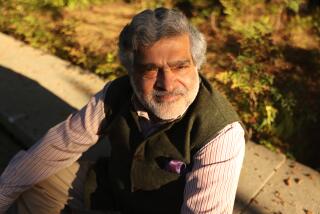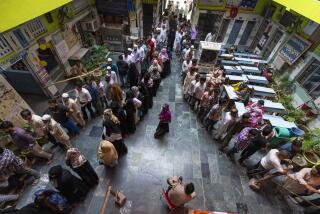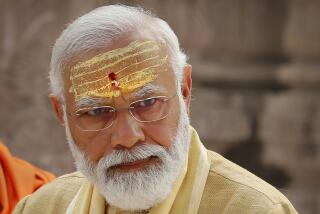Gandhi on the Stump--Tribal Drums, Marigolds, a Boeing 737
- Share via
DHARAMPUR, India — The landing helicopter raised great swirls of dust that blinded the travelers. When the craft settled and the security men flung open its doors, there were a dozen tribal women standing outside, looking as if they had materialized in the dust.
On their heads the women balanced large brass vessels, each filled with water, one brown coconut seed, marigold flowers and mango leaves. It was a traditional Gujarati tribal greeting for Prime Minister Rajiv Gandhi in one of his first stops on a grueling two-day campaign blitz of central and western India.
Only an hour before, the young prime minister had been ensconced in a private apartment aboard his Indian air force Boeing 737 jet. Breakfast was served by a white-gloved attendant. At an air force base, Gandhi transferred to his Soviet-made MI-8 helicopter.
Here, in Gujarat state, he stepped from the craft into a remote and hilly land older than history. No one really knows how long the tribal Dhodia, Varlis and Kiknas peoples have lived here. They are aboriginal to India, virtually untouched by centuries of Aryan, Muslim, Rajput and English rulers.
Fitted With Headdress
The assembled crowd of more than 50,000 people trilled like a giant rookery as Gandhi was fitted with a feathered headdress made by a local tribe and was handed a quiver of arrows and a crude bow. The day of campaigning, Indian-style, had begun.
For the next two days, the prime minister, scion of the great Kashmiri Brahman family of India’s first prime minister, Jawaharlal Nehru, and son of assassinated Prime Minister Indira Gandhi, traveled to 25 cities in four states, campaigning for local candidates in the current state elections.
The two-day elections, Saturday and this Tuesday, will determine whether Gandhi’s Congress-I Party will control state governments as well as the central government. In his two days of campaigning, Gandhi appeared before nearly 2 million people.
The campaign cut a course roughly parallel to the Tropic of Cancer. It passed through barren desert lands with cinnamon-colored mountains, through emerald-green rice paddies and the teak forests of the Sat Pura range. Along the way were sacred Hindu rivers and one of the largest mosques in the world. Atop one lifeless mountain peak was the tomb of a Mogul prince. At the end of the first day of campaigning, the whole entourage slept in a maharajah’s palace.
TV Little Used
The style of the campaign--a journey by helicopter and, after dark, by automobile through the countryside on roads cleared of traffic for hundreds of miles--was perfected by Indira Gandhi in her 16 years as ruler of India.
India is a land where politicians must meet with the masses. Television reaches only a small percentage of the population, and politicians make only rudimentary use of TV for campaigning. In campaign days that lasted from dawn until midnight, Rajiv Gandhi appeared before crowds ranging in size from 40,000 to 200,000.
The campaign stops included some of the country’s most prosperous cities, including Baroda, an oil, petrochemical and atomic energy center, as well as some of the poorest and most backward places on earth.
Dharampur, for example, is called by its own citizens “the poorest of the poor.” For several months every year, the people here fight starvation.
Few in Area Literate
The populace is racked by disease including malaria, tuberculosis, dysentery, worm fever, scabies, rickets and ringworm. Dharampur has the highest leprosy incidence in India. Only 10% of the people of greater Dharampur district, 150 miles north of Bombay, are literate. More than 150 villages in the district lack electricity. Eighty-nine are not connected to the outside world by roads.
The contrast between this town and the developed world, even the developed part of India, is dramatic, but the depth of the difference is not well known here except to a few educated leaders.
As the Gandhi entourage prepared to board the waiting helicopters, a local official handed an appeal for help to one of the prime minister’s aides.
“Dharampur is perhaps one of the poorest regions of the country,” the message stated. “Unless special, concentrated, prolonged efforts are made, it will never enter the mainstream of development.”
The reporters who routinely travel with President Reagan on Air Force One are not served green coconuts fitted with drinking straws to refresh themselves on board. Nor do they stay in palaces at the end of a tiring day.
But the tiny press cadre that accompanied the Indian prime minister--usually only four reporters, including representatives from the two national wire services--had many experiences unknown to American political reporters.
On the short hops between towns, they were given anise seeds to sweeten the breath, tiny seedless grapes, cashew nuts and wet red and green offerings of pan-- a mixture of tobacco, rose flowers and betel nuts wrapped in the leaf of the flame-of-the-forest tree that is to be dropped whole into the mouth and chewed.
One stop was near an elevated field of plantain trees in the famous Indian freedom struggle city of Bardoli, where Indian nationalist Vallabhbhai Patel in 1922 led a peasant revolt against the British, one of the milestones in the independence movement.
Here the 40-year-old Gandhi, a former Cambridge University engineering student, explained why Indians should vote for the Congress-I Party in state elections as well as national parliamentary elections.
“How can you move your cart if it is tied to one camel and one bullock?” he asked. “The plans of the central government can only be translated into action by the Congress governments in the states.”
Pulling into the remote tribal village of Netrang, where wild-eyed dancers oblivious to politics spun and chanted to the beat of a large drum, it was obvious what a great advantage an incumbent prime minister has in campaigning in India. Only the prime minister may use the Indian air force craft. And the Indian air force is the only way to reach places like Netrang, unless one has several days to get there.
“Pandit Nehru was your father, and Indira Gandhi was your mother,” Rajiv Gandhi told the Netrang people. Politics here is reduced to such simple notions. The people applauded enthusiatically. It is only the intellectuals of the cities who complain of the Nehru-Gandhi family dynasty.
The cities on this trip were vastly different from each other and not in the relatively subtle ways that several towns in Iowa, for example, are different.
The tribal areas are backward and poor. But the city of Baroda and its satellite community, Nadiad, are prosperous and modern, with highly educated populations. Baroda is an oil and natural gas city, home to the country’s petrochemical industry and the government heavy-water project. It has tall buildings, Olympic-size swimming pools and sprawling apartment complexes.
Nadiad is a politically charged city in a prosperous agricultural region. Curiously, it is the hometown of hundreds of Indians living in the United States who have bought up hundreds of old motels, many in small cities and towns in California and Texas. The money they send back is a major source of the public wealth here.
Gandhi spent one night in the government circuit house in Chittorgarh, a place famous for its fort, where hundreds of Hindu Rajput women, with the city under siege, once jumped into a flaming pyre, committing mass suicide rather than accepting defeat.
The circuit house is a former maharajah’s palace, an odd combination of Hindu, Muslim and British architecture.
The next day’s travel was into Madhya Pradesh, literally the “middle state” of India, as its name translates. This part of the trip had a more pressing political side to it. Gandhi recently launched a purge of corrupt state politicians, many of whom were dropped from the candidate rolls here. The rejected candidates have fielded rebel slates.
So the crowds in Madhya Pradesh were sometimes a little smaller, their enthusiasm a little less intense, than those of the day before.
The last stop in the two-day swing was Bhopal, the Madhya Pradesh state capital and the site of the Union Carbide gas spill that killed more than 2,000 people last December. Leaders of the state Congress Party leadership, including the chief minister, were accused of negligence after the accident for their failure to warn local residents of the dangers.
But in the national parliamentary elections in December, Bhopal voters came out stronger than ever before for Congress candidates. Gandhi had ordered immediate massive aid for the city, including food rations and money even for those unaffected by the poison.
So despite the disaster and the deaths, the crowd at a police parade ground was one of the most enthusiastic of all.
Afterward, the entire seven-mile path from the parade ground to the airport was lined with people crowded four or five deep. Occasionally the more zealous among them ran in front of the caravan, forcing Gandhi’s car to stop. Women swooned and tore at garlands Gandhi tossed back into their midst.
Later, over a vegetarian dinner served in the comfortable private compartment on his jet, Gandhi talked of his responsibilities as a leader.
His campaign to rid the country of corruption, he said, has made him many enemies. But his enemies are afraid to strike back for two reasons.
The first, he said, is that he did not want to become prime minister. He had been happy as a commercial airline pilot. Therefore, his enemies should know that he is not corruptible and will not compromise.
The second reason his enemies are afraid of him, Gandhi said, is his swelling popular support, which already seems likely to surpass that of his mother.
“There is nothing they can do to me as long as I have the people behind me,” Gandhi said. “Did you see those people?”
More to Read
Sign up for Essential California
The most important California stories and recommendations in your inbox every morning.
You may occasionally receive promotional content from the Los Angeles Times.













